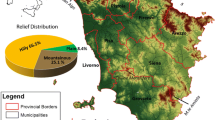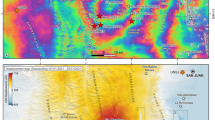Abstract
The objective of this work is to document the deformation pattern of the deep-seated La Clapière landslide for the period 2007–2010 from the combination of L-band synthetic aperture radar (SAR) interferograms, ground-based total station measurements and identification of the slope geomorphological structures. The interferograms are calculated for pairs of ALOS/PALSAR images at a time interval of 46 days. The displacement field derived from the interferograms reveals a non-uniform displacement gradient from the top (subsidence) to the bottom (accumulation). Vertical velocities are calculated from the unwrapped phase values and are in good agreement with ground-based measurements. The results demonstrate the potential of L-band ALOS/PALSAR imagery for the monitoring of active landslides characterized by complex kinematic patterns and by important changes in the soil surface backscattering in time.












Similar content being viewed by others
References
Agliardi F, Crosta G, Zanchi A (2001) Structural constraints on deep-seated slope deformation kinematics. Eng Geol 59:83–102
Berardino P, Fornaro G, Lanari R, Member S, Sansosti E (2002) A new algorithm for surface deformation monitoring based on small baseline differential SAR interferograms. IEEE Trans Geosci Remote Sens 40:2375–2383
Berger M, Moreno J, Johannessen JA, Levelt PF, Hanssen RF (2012) ESA’s sentinel missions in support of Earth system science. Remote Sens Environ 120:84–90
Bois T, Bouissou S, Guglielmi Y (2008) Influence of major inherited faults zones on gravitational slope deformation: a two-dimensional physical modelling of the La Clapière area (Southern French Alps). Earth Planet Sci Lett 272:709–719
Booth AM, Lamb MP, Avouac J-P, Delacourt C (2013) Landslide velocity, thickness, and rheology from remote sensing: La Clapière landslide, France. Geophys Res Lett 40:4299–4304
Cappa F, Guglielmi Y, Soukatchoff V, Mudry J, Bertrand C, Charmoille A (2004) Hydromechanical modeling of a large moving rock slope inferred from slope levelling coupled to spring long-term hydrochemical monitoring: example of the La Clapière landslide (Southern Alps, France). J Hydrol 291:67–90
Cascini L, Fornaro G, Peduto D (2009) Analysis at medium scale of low-resolution DInSAR data in slow-moving landslide-affected areas. ISPRS J Photogramm Remote Sens 64:598–611
Casson B, Delacourt C, Allemand P (2005) Contribution of multi-temporal sensing images to characterize landslide slip surface—application to the La Clapière landslide (France). Nat Hazards Earth Syst Sci 5:425–437
Colesanti C, Wasowski J (2006) Investigating landslides with space-borne synthetic aperture radar (SAR) interferometry. Eng Geol 88:173–199
Corsini M, Ruffet G, Caby R (1994) Alpine and late Hercynian geomorphologic constraints in the Argentera Massif (Western Alps). Eclogae Geol Helv 97:3–15
Delacourt C, Allemand P, Casson B, Vadon H (2004) Velocity field of the “La Clapière” landslide measured by the correlation of aerial and QuickBird satellite images. Geophys Res Lett 31:1–5
Delacourt C, Allemand P, Berthier E, Raucoules D, Casson B, Grandjean P, Pambrun C, Varel E (2007) Remote-sensing techniques for analysing landslide kinematics: a review. Bull Soc Geol Fr 178:89–100
Delteil J, Stephan J-F, Attal M (2003) Control of Permian and Triassic faults on Alpine basement deformation in the Argentera massif (external southern French Alps). Bull Soc Geol Fr 174:55–70
Doin M-P, Lodge F, Guillaso S, Jolivet R, Lasserre C, Ducret G, Grandin R, Pathier E, Pinel V (2011) Presentation of the small baseline processing chain on a case example: The Etna deformation monitoring from 2003 to 2010 using ENVISAT data. Proc. Fringe 2011, ESA, Frascati, Italy. pp. 1–7.
Dramis F, Sorriso-Valvo M (1994) Deep-seated gravitational slope deformations, related landslides and tectonics. Eng Geol 38(3–4):231–243
Ferretti A, Prati C, Rocca F (2001) Permanent scatterers in SAR interferometry. IEEE Trans Geosci Remote Sens 39:8–20
Follacci J-P (1987) Les mouvements du versant de la Clapière à Saint-Etienne-de-Tinée. Bull Liaison Lab Ponts Chaussées 150–151:39–54
Follacci J-P (1999) Seize ans de surveillance du glissement de La Clapière (Alpes Maritimes). Bull Liaison Lab Ponts Chaussées 220:35–51
Follacci J-P, Guardia P, Ivaldi J-P (1988) La Clapière landslide in its geodynamical setting. In: Bonnard C (ed) Proc. 5th Int. Symp. Landslides, vol. 3. Balkema, Brookfield, pp 1323–1327
Follacci J-P, Rochet L, Serratrice J-F (1993) Glissement de La Clapière, St. Etienne de Tinée, Synthèse des connaissances et actualisation des risques, Rapport CETE, Nice, 76pp.
Foster J, Kealy J, Cherubini T, Businger S, Lu Z, Murphy M (2013) The utility of atmospheric analyses for the mitigation of artifacts in InSAR. J Geophys Res Solid Earth 118:748–758
Fruneau B, Achache J, Delacourt C (1996) Observation and modelling of the Saint-Étienne-de-Tinée landslide using SAR interferometry. Tectonophysics 265:181–190
Girault F, Terrier M (1994) Analyse par photogrammétrie des mouvements de terrain : application aux sites de la Clapière, du Friolin, de Boulc et de l’Harmalière. Rapport BRGM, Marseille, 96pp
Goldstein RMM, Zebker HA, Werner CL (1988) Satellite radar interferometry: two-dimensional phase unwrap**. Radio Sci 23:713–720
Guglielmi Y, Cappa F, Binet S (2005) Coupling between hydrogeology and deformation of mountainous rock slopes: insights from La Clapière area (southern Alps, France). C R Geosci 337:1154–1163
Gunzburger Y, Laumonier B (2002) Origine tectonique du pli supportant le glissement de terrain de la Clapière (Nord-Ouest du massif de l’Argentera–Mercantour, Alpes du Sud, France) d’après l’analyse de la fracturation. C. R Geosci 334:415–422
Helmstetter A, Sornette D, Grasso J-R, Andersen J, Gluzman S, Pisarenko V (2004) Slider block friction model for landslides: application to Vaiont and La Clapière landslides. J Geophys Res 109, B02409
Hradecký J, Pánek T (2008) Deep-seated gravitational slope deformations and their influence on consequent mass movements (case studies from the highest part of the Czech Carpathians). Nat Haz 45(2):235–253
Ivaldi J-P, Guardia P, Follacci J-P, Terramorsi S (1991) Plis de couverture en échelon et failles de second ordre associés à un décrochement dextre de socle sur le bord nord-ouest de l’Argentera (Alpes-Maritimes, France). C R Acad Sci II 313:61–368
Jomard H (2006) Analyse multi-échelles des déformations gravitaires du Massif de l’Argentera Mercantour. PhD Thesis, University of Nice, 268pp.
Jomard H, Lebourg T, Tric E (2007) Identification of the gravitational boundary in weathered gneiss by geophysical survey: La Clapière landslide (France). J Appl Geophys 62:47–57
Lebourg T, Binet S, Tric E, Jomard H, El Bedoui S (2005) Geophysical survey to estimate the 3D sliding surface and the 4D evolution of the water pressure on part of a deep seated landslide. Terra Nov 17:399–406
Lebourg T, Hernandez M, Zerathe S, El Bedoui S, Jomard H, Fresia B (2010) Landslides triggered factors analysed by time lapse electrical survey and multidimensional statistical approach. Eng Geol 114:238–250
Li Z, Fielding EJ, Cross P, Muller J-P (2006) Interferometric synthetic aperture radar atmospheric correction: GPS topography-dependent turbulence model. J Geophys Res Solid Earth 111, B02404
Lu P, Casagli N, Catani F, Tofani V (2012) Persistent scatterers interferometry hotspot and cluster analysis (PSI-HCA) for detection of extremely slow-moving landslides. Int J Remote Sens 33(2):466–489
Massonnet D, Feigl KL (1998) Radar interferometry and its application to changes in the Earth’s surface. Rev Geophys 36:441–500
Raucoules D, De Michele M, Malet J-P, Ulrich P (2013) Time-variable 3D ground displacements from high-resolution synthetic aperture radar (SAR). Application to La Valette landslide (South French Alps). Remote Sens Environ 139:198–204
Rosen PA, Hensley S, Peltzer G, Simons M (2004) Updated repeat orbit interferometry package released. EOS Trans Am Geophys Union 85:47–47
Rott H (2009) Advances in interferometric synthetic aperture radar (InSAR). Prog Phys Geogr 33:769–791
Rott H, Nagler T (2006) The contribution of radar interferometry to the assessment of landslide hazards. Adv Sp Res 37:710–719
Schlögel R, Doubre C, Malet J-P, Masson F (2015) Landslide deformation monitoring with ALOS/PALSAR imagery: a D-InSAR geomorphological interpretation method. Geomorphology 231:314–330
Serratrice J-F (2006) Modeling of major rockfalls by spreading: application to the “La Clapière” and “Séchilienne” sites (French Alps). Bull Liaison Lab Ponts Chaussées 263–264:53–70
Squarzoni C, Delacourt C, Allemand P (2003) Nine years of spatial and temporal evolution of the La Valette landslide observed by SAR interferometry. Eng Geol 68:53–66
Stumpf A, Malet J-P, Allemand P, Ulrich P (2014) Surface reconstruction and landslide displacement measurements with Pléiades satellite images. ISPRS J Photogramm Remote Sens 95:1–12
Travelletti J, Malet J-P, Samyn K, Grandjean G, Jaboyedoff M (2013) Control of landslide retrogression by discontinuities: evidence by the integration of airborne- and ground-based geophysical information. Landslides 10:37–54
Wei M, Sandwell DT (2010) Decorrelation of L-band and C-band interferometry over vegetated areas in California. IEEE Trans Geos Remote Sens 48:2942–2952
Zhao C, Lu Z, Zhang Q, de la Fuente J (2012) Remote sensing of environment large-area landslide detection and monitoring with ALOS/PALSAR imagery data over Northern California and Southern Oregon, USA. Remote Sens Environ 124:348–359
Acknowledgments
This work was supported by the EU 7th framework Marie Curie ITN project ‘CHANGES: Changing Hydro-meteorological Risks as Analyzed by a New Generation of European Scientists’ under Grant Agreement No. 263953. ALOS/PALSAR images are provided by the Japan Aerospace Exploration Agency (JAXA) and the European Space Agency (ESA) under the contract C1P.8859. The total station measurements were provided by Centre d’Etudes et d’Expertise sur les Risques, l’Environnement, la Mobilité et l’Aménagement (CEREMA) in agreement with the Direction Départementale des Territoires et de la Mer (DDTM-06). We thank E. Palis (University of Nice) for fruitful discussion on the geomorphology of the landslide.
Author information
Authors and Affiliations
Corresponding author
Rights and permissions
About this article
Cite this article
Schlögel, R., Malet, JP., Doubre, C. et al. Structural control on the kinematics of the deep-seated La Clapière landslide revealed by L-band InSAR observations. Landslides 13, 1005–1018 (2016). https://doi.org/10.1007/s10346-015-0623-0
Received:
Accepted:
Published:
Issue Date:
DOI: https://doi.org/10.1007/s10346-015-0623-0




